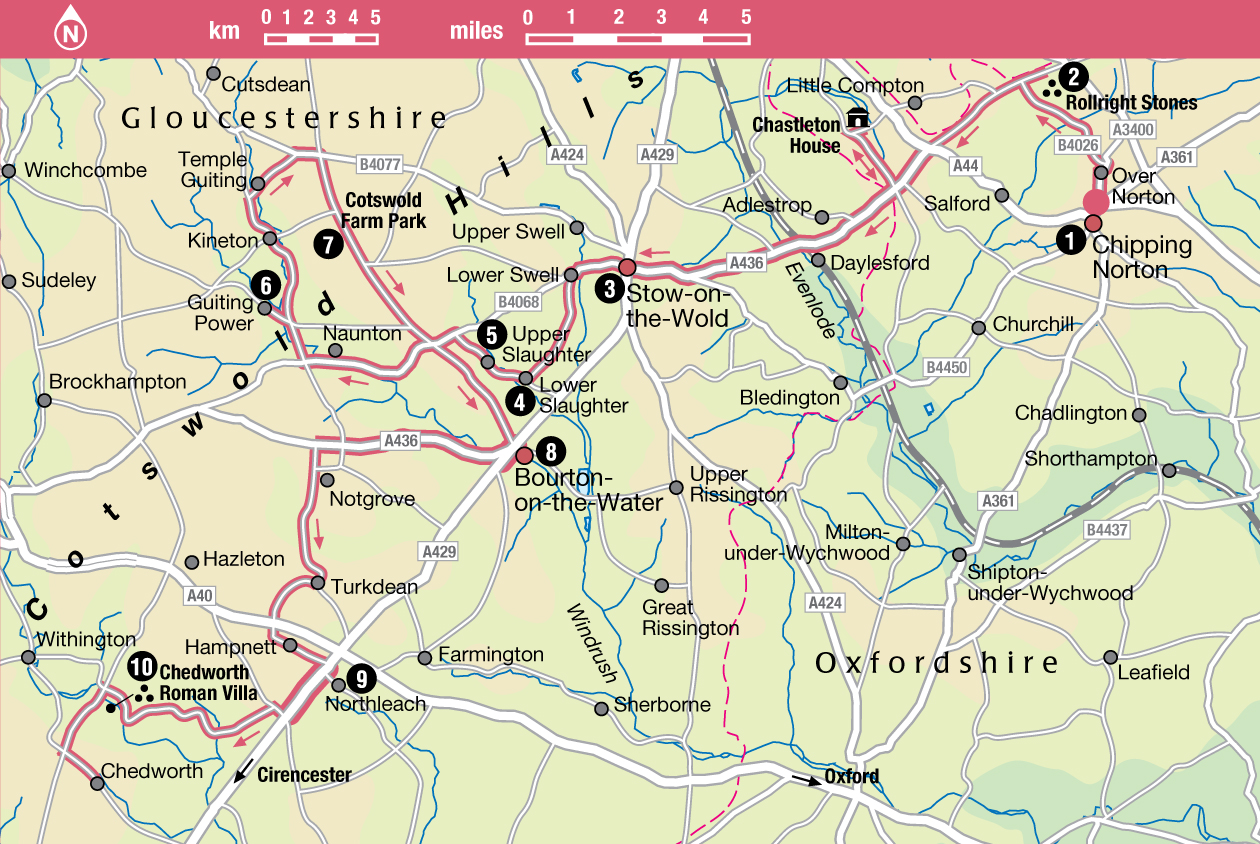
Tour 7: Around Stow-on-the-Wold
Starting in the Oxfordshire Cotswolds, this 60-mile (96km) full-day tour takes you to some of the most popular tourist destinations in the area, as well as a few secret corners
Highlights
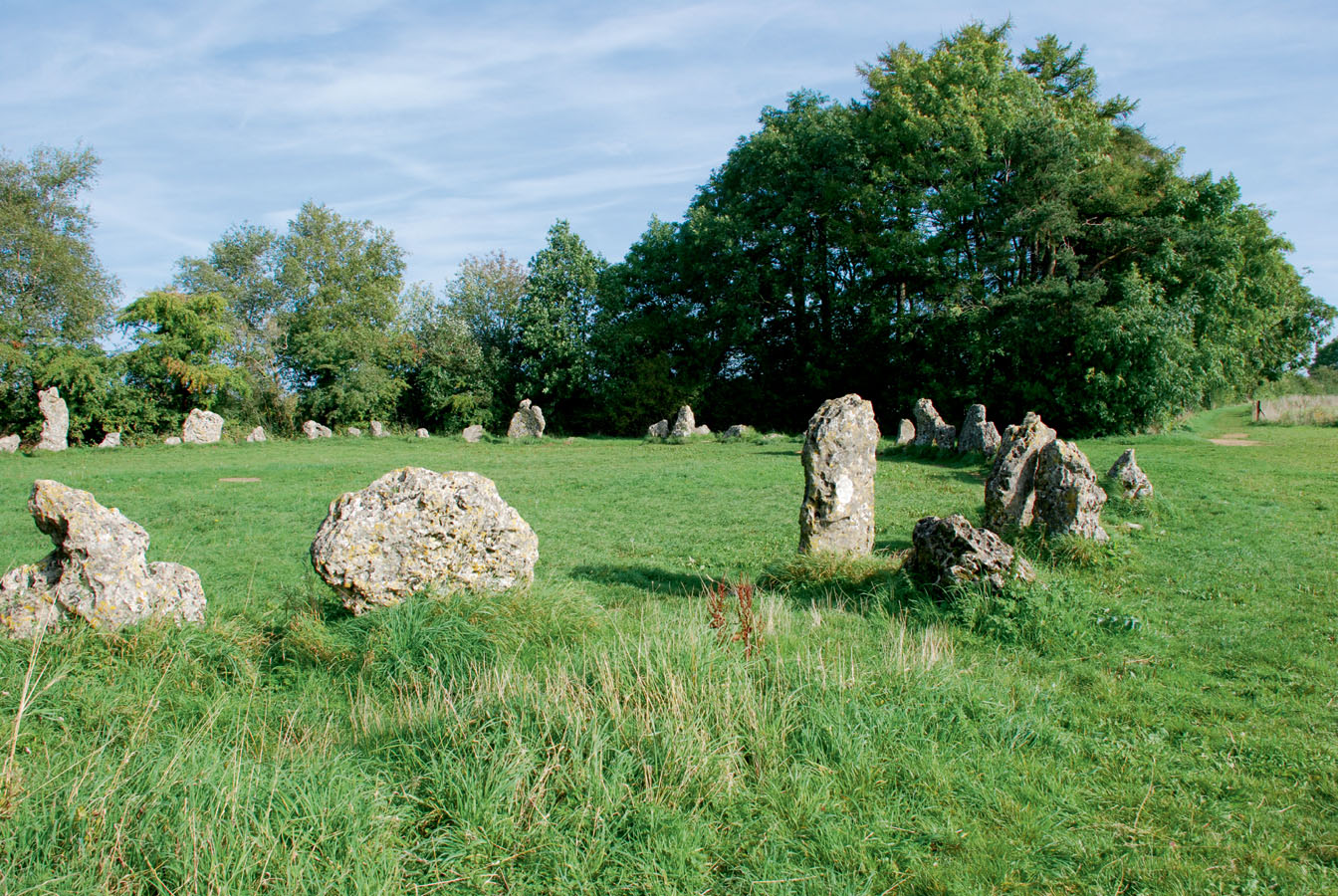
The King’s Men circle, part of the Rollright Stones near Chipping Norton.
Corrie Wingate/Apa Publications
Centred on Stow-on-the-Wold, the tour begins in Oxfordshire at Chipping Norton on the edge of the Cotswolds area. It takes in two ancient sights, at Rollright and Chedworth, some quintessential villages and towns, the tourist honeypot of Bourton-on-the-Water, with plenty for the children, and the rare breeds centre, Cotswold Farm Park.
CHIPPING NORTON AND AROUND
The town of Chipping Norton 1[map], perched on the highest point in Oxfordshire, was once a centre for the Cotswold wool trade. The town has a strong local community spirit and several independent businesses, including antique shops. To find out more of its local history visit Chipping Norton Museum (High Street, tel: 01608-641 712; Easter–Oct Mon–Sat 2–4pm; charge).
Oxfordshire Cotswolds
East of the heart of the Cotswolds, the Oxfordshire Cotswolds are worth a visit. The main centres are Chipping Norton (for more information, click here) and Burford (for more information, click here), and further east the towns of Witney, Charlbury and Woodstock. In between are pretty villages and enchanting countryside, perfect for walkers and cyclists. Rivers, too, play an important part – the Thames and the pretty, wild Windrush. See www.oxfordshirecotswolds.org.
Rollright Stones
From Chipping Norton take the B4026 north, and after about half a mile (1km) turn left in Over Norton and follow signs to the Rollright Stones 2[map] (www.rollrightstones.co.uk; daily sunrise–sunset; small charge in honesty box), which are administered by the Rollright Trust. Located on the right-hand side of the road, they are accessed from a lay-by through a gate in the hedge. The King’s Men circle, made up of 77 stones, dates to about 2500–2000 BC, and according to folklore represents the petrified remains of a king and his knights. Across the field four stones represent the Whispering Knights and over the road a single stone is named the King’s Stone.
Chastleton House
Turn round with care and continue southwest towards Little Compton and at the junction with the A44 turn right for Evesham. Almost immediately turn left onto the A436 for Stow. After 1 mile (2km) turn right to visit Chastleton House (tel: 01494-755 560; www.nationaltrust.org.uk; Wed–Sat late Apr–Sept 1–5pm, mid-Mar–end Mar, Oct 1–4pm; charge, timed tickets). This is one of England’s finest and most perfect Jacobean houses, which remained virtually untouched for nearly 400 years. It was acquired by the National Trust in the mid-1990s and is wonderfully atmospheric, even down to the ceiling in the old kitchen, which has never been cleaned. The gardens are a delight, and include a lawn where the rules of modern croquet were laid down in 1865.
STOW-ON-THE-WOLD
Return to the A436 for Stow. Just west off this road is the village of Adlestrop made famous in a poem by Edward Thomas (for more information, click here). Stow-on-the-Wold 3[map], according to an ancient rhyme, is ‘where the wind blows cold’. The truth of this becomes chillingly apparent if you visit Stow, the Cotswolds’ highest town (situated at around 754ft/230 metres) on a grey day in February, but in summer the town has a festive atmosphere, packed with coach-trippers and antique hunters coming to browse in the town’s good art and antique galleries (for more information, click here).
Shopping in Stow
Stow-on-the-Wold is a magnet for shoppers in the Cotswolds with antique shops, galleries, fine food delis, independent boutiques and furniture stores. Classic lines and country styles abound, with stylish gifts from the Cotswolds also on sale; there is little that is tacky. The town is the home of the flagship Scotts of Stow, with everything for the kitchen and home.
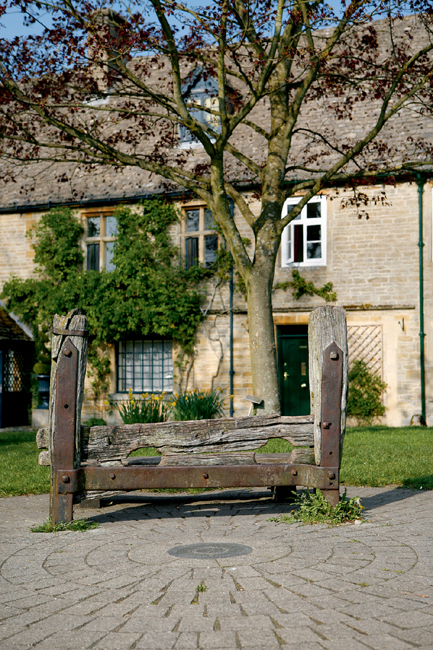
The stocks on the green in Stow-on-the-Wold.
Alamy
Stow’s huge market square testifies to the size of the flocks that used to be driven here for sale between 1107 (when Henry I granted the town its charter) and the 1980s, when the Stow Horse Fairs were moved away from the town because of the crime and chaos they created. Wooden stocks survive on the green in Stow’s marketplace as a warning to miscreants.
Stow’s church contains memorials to several of those who died in the last (and perhaps the fiercest) battle of the Civil War, which took place on 21 March 1646. The church was used as a prison and held some 1,000-plus Royalists at one time, suffering much damage as a result. The curious north porch, which has two yew trees flanking the doorway growing out of the masonry, was added as part of the 1680 restoration. Inside there is a fine slate floor memorial near the altar to the Royalist Hastings Keyt, dressed in uniform sash and helmet. Easily missed at the back of the church is a naturalistically carved hare, part of a Saxon carving from the first church on the site, founded in AD 986.
Remembering Adlestrop
The village of Adlestrop was immortalised in an eponymous poem by the celebrated World War I poet Edward Thomas. He was travelling on a train that made an unscheduled stop at the station just before the war that was to claim his life began. The station is now long gone but the poem is inscribed on a plaque in Adlestrop’s bus shelter beneath the sign salvaged from the old station.
PERFECT COTSWOLD VILLAGES
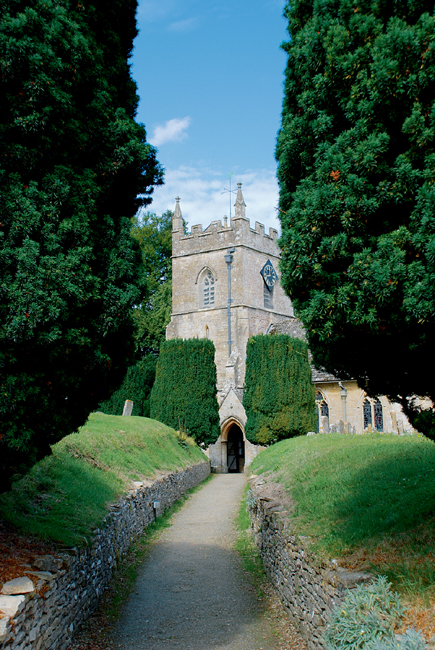
Yew-lined path leading to the delightful Norman church at Upper Slaughter
Corrie Wingate/Apa Publications
Surrounding Stow are some of the Cotswolds’ prettiest villages. One mile (1.5km) west on the B4068 and reached by leaving Stow by going over the crossroads with the A429 (no sign, but opposite the Unicorn Hotel) is the village of Lower Swell. This name perhaps refers to the ancient well in the village. There are also some remarkable Norman carvings in its generally over-restored church. There’s a village war memorial designed by Edwin Lutyens, who was also the architect of nearby Abbotswood house, which can be seen when the excellent gardens are open under the National Gardens Scheme (for more information, click here).
The Slaughters
Go through the village following signs for The Slaughters, past the Golden Ball pub and then bear left for Lower Slaughter 4[map]. The village is almost too perfect, and the slough (or marsh) from which the village derives its name has been tidied up, so that the River Eye now flows between grassy banks and colourful cottage gardens beneath a series of stone bridges. At the western end of the village you can visit the Old Mill (tel: 01451-820 052; www.oldmill-lowerslaughter.com; daily 10am–6pm; charge), last used commercially in 1958. There is a mill museum, craft shop and tearooms (for more information, click here), as well as a parlour famous for its home-made ice cream.
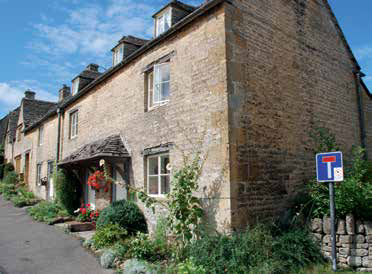
A line of handsome terraces on the green at Guiting Power.
Corrie Wingate/Apa Publications
A delightful lane follows the Eye upstream to Upper Slaughter 5[map], with a good view on the right of the Elizabethan manor (now Lords of the Manor Hotel, (for more information, click here)) as you enter the village. The church has fine Norman details, but its most curious feature is the large, mock-medieval tomb of the Reverend F.E. Witts (died 1854), whose Diary of a Cotswold Parson was discovered some years ago.

Rolling pastures near Temple Guiting.
Corrie Wingate/Apa Publications
For a short but interesting walk through the village, take the left-hand path from the church and turn left to reach the point where the Eye forms a ford. Turn right by the ford and follow the trout-filled stream, past banks of bullrushes and waterside plants where dragonflies dart. Turn right uphill once the path meets the road to return to the village green in front of the church. Turning right from the church, take the road signposted to Cheltenham, bringing you to the B4068. Turn left and continue on the road to Naunton, 4 miles (6.5km) west, which passes through a valley filled with the kinds of flowers that only grow on unimproved limestone pasture – cowslips in spring, yellow rattle and rare orchids in summer. The village church has an interesting monument to Ambrose Oldys, vicar of Adderbury in Oxfordshire, who was ‘barbarously murthered by ye rebells’ in 1645. The inscription tells of his unshakeable loyalty to the Crown and his adherence to the established Church. Volunteers have restored the lovely dovecote in the village.
The Guitings
Passing Naunton church take the steep uphill road, turning right at the top, and follow signs for Guiting Power 6[map], another handsome village, with a fine 15th-century cross carved with the Virgin and Child and the Crucifixion standing on the green. The handsome cruciform church has an hourglass carved in stone over the doorway to remind us of the brevity of life and there are a variety of humorous portrait heads carved on the roof supports inside.
Just over a mile (2km) to the north through Kineton, Temple Guiting (so called because it once belonged to the Knights Templar) is not as pretty, but its church does have a fine 18th-century nave and an intricately modelled plaster coat of arms of George II, flanked by a rampant lion and unicorn. The church can be found by turning right opposite the school, some 50 yds/metres down, set back from the road on the right. From the village continue on to the B4077 and at the crossroads turn right for Bourton-on-the-Water.
COTSWOLD FARM PARK
Just over a mile (2km) to the south is the Cotswold Farm Park 7[map] (tel: 01451-850 307; www.cotswoldfarmpark.co.uk; daily mid-Mar–mid-Oct 10.30am–5pm, Nov–mid-Dec, early Feb–mid-Mar 10.30am–4pm; charge). Founded by Joe Henson in 1970, this was the first farm in England to specialise in the rescue of rare breeds of farm animal, and is now run by Joe’s son, Adam, who also presents a farm-based segment weekly on the BBC programme Countryfile. Some of the animals here were only recently rescued from extinction: the White Park Cattle, for example, an ancient Celtic (pre-Roman) strain once bred for hunting and for ornament, and the Norfolk Horn Sheep (down to the last four rams and five ewes before a breeding programme was initiated).
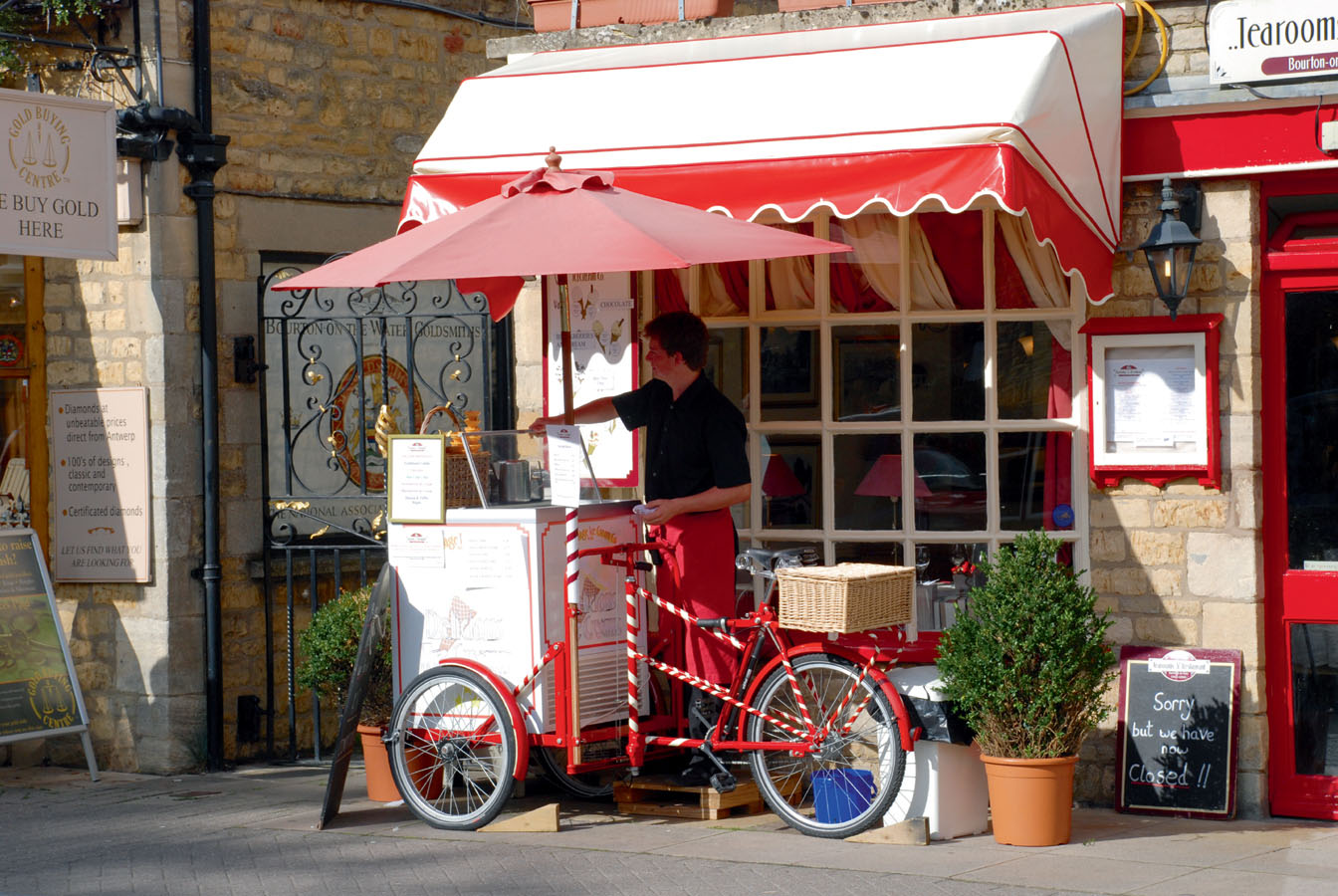
Roadside vendor in Bourtonon-the-Water.
Corrie Wingate/Apa Publications
For young visitors, the real appeal of the Cotswold Farm Park is that the animals are nearly all friendly, contented and placid. The Touch Barn offers the chance for the family to make friends with small animals such as rabbits, ducklings and baby goats and it is possible to bottle-feed animals, too. Other attractions for youngsters are the Jumping Pillows, Lion Maze, Adventure Playground, Farm Safari and the Wildlife Walk.
BOURTON-ON-THE-WATER
Another cluster of children’s attractions can be found in Bourton-on-the-Water 8[map], 6 miles (10km) south. This whole village (www.bourtoninfo.com) is given over to tourism, but even the tacky gift shops do not detract from the charm of what has been dubbed ‘the Venice of the Cotswolds’ because of the elegant 18th-century bridges that cross the River Windrush as it flows through the centre of the village. One of Bourton’s best attractions is the enchanting Model Village at the Old New Inn in the High Street (tel: 01451-820 467; www.theoldnewinn.co.uk/village; daily late Mar–late Oct 10am–6pm, late Oct–late Mar 10am–4pm; charge) depicting Bourton (as it was in 1937) at one-ninth scale. Keep an eye out for novel features such as the bonsai trees, and the choir and organ music just discernible if you put your ear to the door of the parish church.

Bourton-on-the-Water is known as the ‘Venice of the Cotswolds’.
Corrie Wingate/Apa Publications
Close by in Rissington Road is Birdland (tel: 01451-820 480; www.birdland.co.uk; Apr–Oct daily 10am–6pm, Nov–Mar until 4pm; charge). The best time to visit is at around 2.30pm when the 500 or so birds are fed, from the fruit-eating parrots to the fish-eating penguins. Most of the birds here were bred at the park and they are so tame that they are allowed to wander freely. The indoor Discovery Zone is a bonus in wet weather.
Bourton’s other attractions include the Bourton Model Railway (Box Bush, High Street; tel: 01451-820 686; www.bourtonmodelrailway.co.uk; June–Aug daily 11am–5pm, Sept–May Sat–Sun 11am–5pm, Jan limited hours; charge) which will entertain anyone with nostalgic yearnings for the train set of their youth; the Cotswold Perfumery (tel: 01451-820 698; www.cotswoldperfumery.co.uk; Mon–Sat 9.30am–5pm, Sun 10.30am–5pm; charge for factory tours), just over the river, with exhibits and a programme on how perfumes are made; and the Cotswold Motoring Museum and Toy Collection (Sherbourne Street; tel: 01451-821 255; www.cotswoldmotoringmuseum.co.uk; Feb–Oct daily 10am–6pm; charge). The latter is the home of Brum, which younger children will recognise as the little yellow car that features in the television programme of the same name. The museum is also an Aladdin’s cave of motoring memorabilia.
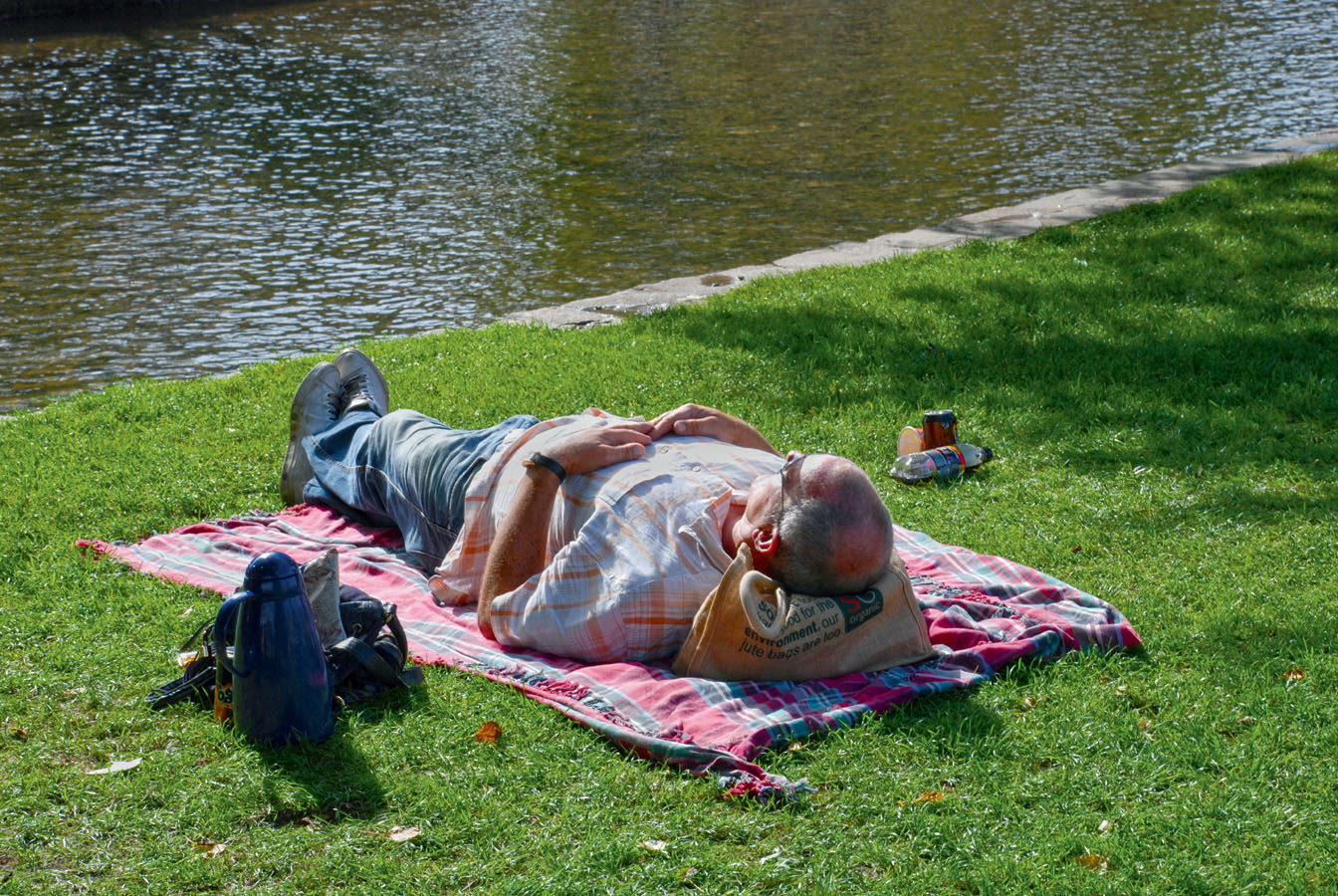
Relaxing by the banks of the Windrush on a warm summer’s day.
Corrie Wingate/Apa Publications

The Norman church of St Bartholomew in Notgrove.
Alamy
As an antidote to museums, your children might enjoy visiting the Dragonfly Maze (Rissington Road; tel: 01451-822 251; www.thedragonflymaze.com; daily Apr–Sept 10am–5pm, Oct–Mar times vary so call to check; charge) with its labyrinth of yew-lined pathways and intriguing clues. Or you can explore Salmonsbury Meadows Nature Reserve (tel: 01452-383 333; daily; free) located on the edge of Bourton off Station Road, a meadowland along the tiny River Eye. Look out for roe deer and foxes, water voles and rare orchids (for more information, click here).
CHURCHES AND VILLAGES
From Bourton, you can either take the direct road to Northleach along the A429 Fosse Way, or you can meander through three of the least-spoiled villages to be found in the Cotswolds – Notgrove, Turkdean and Hampnett – leaving Bourton westwards on the A436 signposted to Cheltenham.
Notgrove and Turkdean
The idyllic setting of Notgrove church (4 miles/6km south off A436) alone makes it worth a visit, but other treasures include a tapestry made in 1954 showing the village, church and manor glimpsed through hazel trees (a reference to the village name), and a lovely stained-glass fragment from c.1300, depicting the Virgin and Child. From the church continue up to the main road turning left for Turkdean, where the church in the middle of the village is an architectural puzzle, a patchwork of Norman masonry, the remains of a 15th-century St Christopher wall painting and stained glass added in 1924. Continuing downhill, cross the ford and head southwest to Hampnett.
Greystones and Salmonsbury
This site, where farming has been part of the landscape for 6,000 years, is managed by Gloucestershire Wildlife Trust and covers 163 acres (66 hectares). Archaeological remains can be seen behind Greystones Farm. Salmonsbury Meadows is designated a Site of Scientific Importance for its natural habitat, one of the largest and richest in the Cotswolds with rare wild plants and a stretch of the River Eye.
Hampnett
Across the A40 is Hampnett, which looks as if time stopped here some time in the pre-industrial age, with its farmhouses grouped around a rough green where the River Leach springs out of the ground and begins its journey to join the Thames at Lechlade. The church, with its Norman carvings of birds on the chancel-arch capitals, is made more delightful by the 19th-century wall paintings, executed by the rector, the Reverend Wiggin, in an attempt to re-create the original Norman appearance. Pass the church and continue to meet the A429.
Northleach
The road from Hampnett joins the A429 just above the Old Prison (on the right) at Northleach 9[map], adjacent to which is a centre with an exhibition produced by the Cotswold Conservation Board, depicting the Cotswolds Area of Outstanding Natural Beauty. Built in 1791, the prison reflected the reforming ideas of local philanthropist, Sir George Onesiphorus Paul, and it set new standards for prison health and hygiene. The cell block and courthouse holds the Lloyd Baker Cotswold Rural Collection of Agricultural Carts (tel: 01451-862 000; Apr–Oct Wed–Sat 11am–4pm; free).
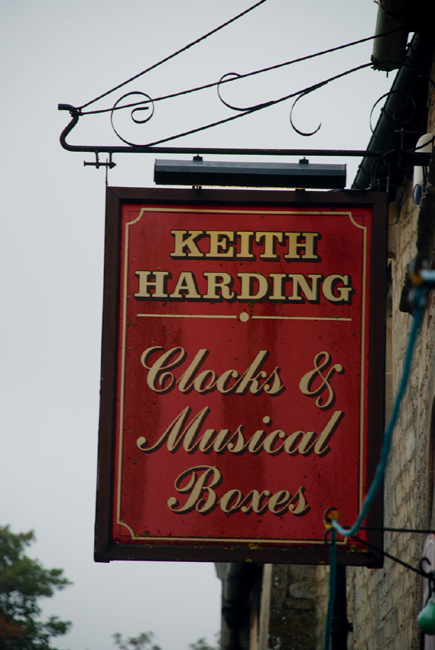
Welcome to a world of mechanical music.
Corrie Wingate/Apa Publications

Mellow facades at Hampnett.
Corrie Wingate/Apa Publications
By contrast, turn left at the traffic lights for the town centre and Keith Harding’s World of Mechanical Music (High Street; tel: 01451-860 181; www.mechanicalmusic.co.uk; daily 10am–5pm; charge), which is concerned with the intricate niceties of antique musical boxes and clocks, self-playing pianos and early gramophones. From the museum it is a short step up the churchyard path to one of the Cotswolds’ finest churches, built with profits from the wool trade. Evidence of the industry is found throughout the church; the printed guide will tell you where to find fine 15th-century brasses decorated with sheep, woolsacks, woolmarks and shears. Some have dates in Arabic numerals, indicating trade contact with Spain and North Africa. Best of all is the Fortey brass, with its border decorated with slugs, snails, hedgehogs and strawberries. From Northleach take the A429 heading south towards Cirencester.
CHEDWORTH
Signs off the A429 will direct you to the remains of Chedworth Roman Villa )[map] (tel: 01242-890 256; www.nationaltrust.org.uk; daily Apr–Oct 10am–5pm, Nov, Feb–Mar 10am–4pm; charge), delightfully set in a wooded combe overlooking the Coln Valley. The mosaics here include a charming depiction of the seasons, with winter personified as a peasant in a billowing hooded cloak, bringing home a hare for the pot and a branch for fuel. In one corner of the site is a nymphaeum, a small sanctuary to the goddess of the spring that supplied the villa and its bathhouse with water. The Roman inhabitants introduced the edible snails that are found in and around the villa, especially on damp days, and which inhabit the railway cuttings above the villa, now a nature reserve.
Return to the road, turn left towards Withington and at the staggered crossroads turn sharp left and follow signs to the village of Chedworth. The church (on the left at the top of the hill as you enter the village) is another handsome Norman building, and its stone-carved 15th-century pulpit is one of the finest in the Cotswolds. Not far away is the atmospheric Seven Tuns pub, with an outdoor terrace and excellent food – the perfect place to contemplate the way in which the houses of Chedworth seem to cling to a series of terraces above the Coln Valley.
Eating Out
Chipping Norton
Wild Thyme Restaurant
10 New Street; tel: 01608-645 060; www.wildthymerestaurant.co.uk; Tue–Sat noon–2pm, 7–9pm.
This established local favourite serves modern British food with Mediterranean influences. Local seasonal produce is used, such as pigeon, venison and wild rabbit. £££
Stow-on-the-Wold
The Vine Leaf
10 Talbot Court; tel: 01451-832 010; www.thevineleaf.co.uk; Tue–Sat 11am–9pm, Sun 11am–5pm (summer only).
Locally sourced food served throughout the day. Look out for specials and set menus. Tables outside for summer eating. £–££
Lower Slaughter
Old Mill
Mill Lane; tel: tel: 01451-820 052; www.oldmill-lowerslaughter.com; Apr–Oct daily 10am–6pm, check for winter times.
Pleasant riverside complex with a museum, tearoom and ice-cream parlour, gift and craft shop Treat yourself to organic ice-cream delights including summer berries, ground coffee or butter crunch flavours. £
Bourton-on-the-Water
The Croft
Victoria Street; tel: 01451-821 132; daily 9am–6pm, evening menu Thur–Mon 6–8pm, Sat until 9pm.
Located in Chester House B&B, The Croft has lovely river views; ideal for light bites or full meals. Booking advised for dinner. £–££
Northleach
The Wheatsheaf
West End; tel: 01451-860 244; www.cotswoldswheatsheaf.com; Mon–Sat noon–2.30pm, 6–9.30pm (until 10pm Fri–Sat), Sun noon–3pm.
Appealing to locals and visitors alike, the pub was refurbished in 2011. Mains range from beer battered whiting to mouth-watering steaks, served with a choice of sauces. Round off with a vanilla crème brûlée or Black Forest sundae. ££